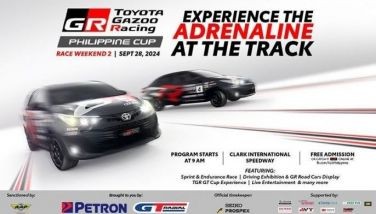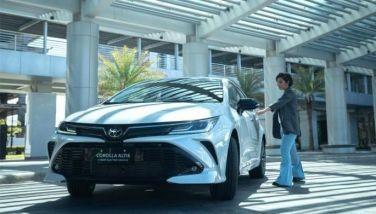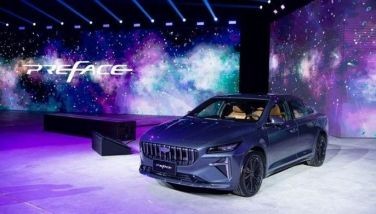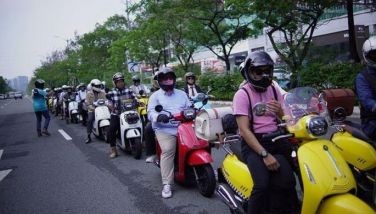Shattering Motorcycle Myths
December 14, 2005 | 12:00am
It used to be that when I tell a friend, a casual acquaintance or a relative that I’m into motorcycling, they would normally give me a look like I’m suicidal. The conversation will always end with something like "Think about your family, especially your children, who might grow up without a father," or a similar statement to that effect.
But nowadays, when I tell people I’m into motorbikes, many respond with "I’m thinking of getting into bikes, too," or "I just got a bike myself." It might be because of the spiraling cost of fuel or the increasingly heavy traffic, but people are beginning to see motorcycles as sensible transportation and not just as a hobby or a toy of riders with a death wish. But whatever the case, motorcycle riding is finally coming out as a safe and fun alternative to go around town.
Unfortunately, some age-old myths about motorcycling still exist and some people still have misconceptions about riding motorbikes because of these. Please allow me to share with you four of these myths and popular misconceptions:
Motorcycles are a minority. Drivers of four-wheeled vehicles especially large trucks and buses, tend to bully motorcyclists because they think that their trucks and buses outnumber motorcycles, plus the fact that their vehicle is much, much larger. They may be larger in physical size but the truth is, according to DOTC-LTO data, the motorcycle population is much larger than the bus and the truck population, as well as the car population. There are now over two million motorcycles registered nationwide (or almost 40 percent of the total national vehicle population) with almost 200,000 in Metro Manila alone (or 20 percent of Manila’s vehicle population) compared to 36,029 buses nationwide (1 percent) with 11,256 buses in the National Capital Region (1 percent) or 292,168 trucks (10 percent) with 71,285 trucks (8 percent) cluttering up the NCR while cars constitute 862,847 (29 percent) with 521,939 cars in the Metro (62 percent). The motorcycle figures do not include tricycles which number about 603,827 units (20 percent), 63,243 of which are picking up fares in Metro Manila constituting seven percent of the metropolis’ vehicle population. Thus, if all two million motorcyclists were to unite, they can put up their own congressional party list and install their own congressman or woman. In an election year, the bikers and their immediate family would be a considerable voting block of about 10 to 15 million voters. Think of all the motorcycle-friendly legislatures that can be passed in Congress!
Motorcycles are inherently dangerous. My mama always told me that life is like a box of choco…oops, I meant she used to tell me that riding a bike is like having one foot in the grave. She got that idea from my grandpa who crashed his new Triumph Montesa 250 Twin when he had a diabetic seizure while riding in Vietnam in 1968. And he didn’t know that he was diabetic until he had his seizure! Tsk, tsk, his near-death accident wasn’t the motorcycle’s fault after all. Well, reports from the NCR Traffic Management Office (TMO) echoes the safety records of motorbikes. According to the NCR-TMO data base, three accidents happen to each registered bus yearly, compared to one accident per 1.5 cars and one per 1.75 trucks. Motorcycles on the other hand, have the safest record with one accident per eight registered motorbikes while an accident occurs for every six registered tricycles. Furthermore, the NCR-TMO reports that fatality rates from motorcycle accidents constitute only one percent compared to two percent for cars and the same percentage for trucks and three percent for buses and the same for jeepneys. Unfortunately, while it’s a statistical fact that motorcycles are not accident prone, it is a reality that motorbikes are vulnerable. That’s why riders should concentrate more on their riding than drivers of four-wheeled vehicles do on their driving. Average driving of an automobile requires around 4/10ths of your concentration (or lower) while riding a motorcycle requires 10/10ths or your complete attention. Of course, wearing the proper riding gear (helmet, eye protection, padded jacket, gloves, long pants, knee protector and ankle-high boots) ensures rider safety, too.
Motorcycles are polluters. Admittedly, some motorcycles do litter the environment with white smoke or unburned hydrocarbons emitting from their poorly-maintained engines and noise from their incorrectly modified, unrestricted or straight-flow exhaust systems. Fortunately, these bikes are the minority rather than the majority. But if you really think about it, there are less pollutants spewed into the air by a basic single-cylinder motorcycle carrying a single rider than there are pollutants spewed by a basic four-cylinder car carrying a single occupant. Motorbikes consume less fuel, too, which can help reduce the country’s dependence on oil. Motorcycles also occupy less space than cars, which could solve the traffic problem if more people rode than drove. More over, motorcycles are infrastructure efficient, meaning you can fit more bikes into a space occupied by one car. For example, a parking slot for one car can accommodate five motorbikes, and these can help preserve the remaining greenery instead of converting the space into another parking lot.
Motorcycles are impractical transportation. In our country of dry and wet seasons, many claim that motorcycling has no place: it’s too hot to ride in summer and too wet to ride during the rainy season. Unfortunately, these claims are made by people who don’t really ride. I ride during summer wearing an armor-padded mesh jacket and not only do I look cool, but I ride cooled by the wind. I wear a vented rain coat during the rainy season and though I may be wet with a little sweat and rain, I’ve never been caught in a traffic jam caused by a flooded street. I can always turn around and find another unclogged or moving route whenever I get caught in a flood-caused traffic jam. And regardless of weather, riding always saves me between 30 to 60 percent of the travel time compared to driving. I get to where I’m going faster and I can go to more places given the same amount of time. Don’t get me wrong, I love to drive cars but not in our traffic-snarled city streets. Not unless I have to, that is.
So, there you have it. Based on empirical data, motorcycles are proven to be safer, and they reduce travel time, can help reduce the national fuel consumption, spew fewer emissions and are infrastructure efficient. Bikes also allow a lower entry level for low- to middle-income blue-collar workers to acquire their own means of transportation and the motorcycle may be the untapped development program that can move our nation forward.
I can only hope that one day the Philippine motorcycle industry will become as important and as dynamic as the local car industry like in Indonesia, where I came from recently. I had a chance to get an overall view of the Indonesian motorcycle industry when I rode a new Yamaha motorcycle model from Jogjakarta and around Java Island to the city of Medan in Sumatra Island in the Yamaha Pan Asean Touring series. With a human population of 222 million and a motorcycle population of 58 million, Indonesia has a human/motorcycle density ratio of 4:1 compared to our country which has 85 million Filipinos and only two million motorcycles, or a ratio of 42:1. Their motorcycle industry sells about five million bikes annually and makes Indonesia the largest motorcycle market in the Asean region. The Philippine motorcycle industry sells only about 550,000 bikes a year but promises a lot of market potential. And as I mentioned earlier, motorcycles maybe the untapped potential to move our economy forward.
Oh, and before I forget, riding a motorcycle is great fun, too! So swing a leg over a bike and ride safely!
Corrections galore! It seems that the Backseat Drivers out there are even more informed of the goings on in our fickle-minded authorities’ minds. Here are some corrections and comments from last week.
My driver was caught in Pasay violating the UVVRP. The Pasay enforcers say that they have a new ordinance and that they no longer have the 10Am to 3PM window. — 09178225288
For your information, as a resident of Mandaluyong, the 10AM to 3PM window was put back in place. I believe that besides Makati, San Juan strictly enforces the coding scheme without the window. — 09172411837
Correction! In last week’s Backseat Driver, you did not include San Juan, which does not allow the 10AM to 3PM window in the color coding scheme. — 09178126524 (Okay, to set things straight, we’ve asked our MMDA reporter Michael Punongbayan to get the low-down on the color coding updates. We’ll feature his article on it next week.)
Let’s pray that the MMDA realizes that the u-turn scheme at the Katipunan-Aurora area does not work ands that it is in fact causing the traffic jam in that area. — 09175368757
Can’t the MMDA do something about the pedicabs that ply the Quezon Avenue-EDSA intersection at night? They’re a nuisance & danger to drivers. — 09209280835
Authorities should apprehend motorists who let their children stay in the front seat. — 09179876627
My new car’s fuel pump had to be changed three times from March 2004 to December 2005. Can the car be considered a lemon? And can I be given a replacement? — 09179295801 (Your car, from a consumer’s point of view, can indeed be considered a lemon. Unfortunately, since the "lemon law" is still being set aside in favor of a million congressional inquiries in aid of legislation, there is no technical definition as mandated by law of a "lemon car". You can, if you have the money, time and patience, always take the manufacturer and/or distributor to court.)
The Innova uses 205/65 R15 wheels, which seems smaller when compared to other SUVs. Does this have any effect on its performance, ride or fuel consumption? — 09163917404 (First off, let’s get things straight. The Toyota Innova is not an SUV but more a variation of the AUV. Performance parameters of both differ on many levels, therefore, the Innova cannot exactly be compared to other SUVs. Next, manufacturers have this practice of putting in the specs that maximize fuel efficiency numbers, comfort and driving dynamics of vehicles given budgets and other considerations. I’d say that the Innova isn’t an exception to that general rule.)
I’m very interested to buy a new car, especially with a diesel engine. Could you please feature the new Hyundai CRDi powered cars? — 09164358799 (James Deakin already did a story on the Matrix CRDi. We’ll try to do another test drive story the moment we get our hands on another CRDi model from Hyundai.)
Speak out, be heard and keep those text messages coming in. To say your piece and become a "Backseat Driver", text PHILSTAR<space>FB<space>MOTORING<space>YOUR MESSAGE and send to 2333 if you’re a Globe or Touch Mobile subscriber or 334 if you’re a Smart or Talk ’n Text subscriber or 2840 if you’re a Sun Cellular subscriber. Please keep your messages down to a manageable 160 characters. You may send a series of comments using the same parameters.
But nowadays, when I tell people I’m into motorbikes, many respond with "I’m thinking of getting into bikes, too," or "I just got a bike myself." It might be because of the spiraling cost of fuel or the increasingly heavy traffic, but people are beginning to see motorcycles as sensible transportation and not just as a hobby or a toy of riders with a death wish. But whatever the case, motorcycle riding is finally coming out as a safe and fun alternative to go around town.
Unfortunately, some age-old myths about motorcycling still exist and some people still have misconceptions about riding motorbikes because of these. Please allow me to share with you four of these myths and popular misconceptions:
Motorcycles are a minority. Drivers of four-wheeled vehicles especially large trucks and buses, tend to bully motorcyclists because they think that their trucks and buses outnumber motorcycles, plus the fact that their vehicle is much, much larger. They may be larger in physical size but the truth is, according to DOTC-LTO data, the motorcycle population is much larger than the bus and the truck population, as well as the car population. There are now over two million motorcycles registered nationwide (or almost 40 percent of the total national vehicle population) with almost 200,000 in Metro Manila alone (or 20 percent of Manila’s vehicle population) compared to 36,029 buses nationwide (1 percent) with 11,256 buses in the National Capital Region (1 percent) or 292,168 trucks (10 percent) with 71,285 trucks (8 percent) cluttering up the NCR while cars constitute 862,847 (29 percent) with 521,939 cars in the Metro (62 percent). The motorcycle figures do not include tricycles which number about 603,827 units (20 percent), 63,243 of which are picking up fares in Metro Manila constituting seven percent of the metropolis’ vehicle population. Thus, if all two million motorcyclists were to unite, they can put up their own congressional party list and install their own congressman or woman. In an election year, the bikers and their immediate family would be a considerable voting block of about 10 to 15 million voters. Think of all the motorcycle-friendly legislatures that can be passed in Congress!
Motorcycles are inherently dangerous. My mama always told me that life is like a box of choco…oops, I meant she used to tell me that riding a bike is like having one foot in the grave. She got that idea from my grandpa who crashed his new Triumph Montesa 250 Twin when he had a diabetic seizure while riding in Vietnam in 1968. And he didn’t know that he was diabetic until he had his seizure! Tsk, tsk, his near-death accident wasn’t the motorcycle’s fault after all. Well, reports from the NCR Traffic Management Office (TMO) echoes the safety records of motorbikes. According to the NCR-TMO data base, three accidents happen to each registered bus yearly, compared to one accident per 1.5 cars and one per 1.75 trucks. Motorcycles on the other hand, have the safest record with one accident per eight registered motorbikes while an accident occurs for every six registered tricycles. Furthermore, the NCR-TMO reports that fatality rates from motorcycle accidents constitute only one percent compared to two percent for cars and the same percentage for trucks and three percent for buses and the same for jeepneys. Unfortunately, while it’s a statistical fact that motorcycles are not accident prone, it is a reality that motorbikes are vulnerable. That’s why riders should concentrate more on their riding than drivers of four-wheeled vehicles do on their driving. Average driving of an automobile requires around 4/10ths of your concentration (or lower) while riding a motorcycle requires 10/10ths or your complete attention. Of course, wearing the proper riding gear (helmet, eye protection, padded jacket, gloves, long pants, knee protector and ankle-high boots) ensures rider safety, too.
Motorcycles are polluters. Admittedly, some motorcycles do litter the environment with white smoke or unburned hydrocarbons emitting from their poorly-maintained engines and noise from their incorrectly modified, unrestricted or straight-flow exhaust systems. Fortunately, these bikes are the minority rather than the majority. But if you really think about it, there are less pollutants spewed into the air by a basic single-cylinder motorcycle carrying a single rider than there are pollutants spewed by a basic four-cylinder car carrying a single occupant. Motorbikes consume less fuel, too, which can help reduce the country’s dependence on oil. Motorcycles also occupy less space than cars, which could solve the traffic problem if more people rode than drove. More over, motorcycles are infrastructure efficient, meaning you can fit more bikes into a space occupied by one car. For example, a parking slot for one car can accommodate five motorbikes, and these can help preserve the remaining greenery instead of converting the space into another parking lot.
Motorcycles are impractical transportation. In our country of dry and wet seasons, many claim that motorcycling has no place: it’s too hot to ride in summer and too wet to ride during the rainy season. Unfortunately, these claims are made by people who don’t really ride. I ride during summer wearing an armor-padded mesh jacket and not only do I look cool, but I ride cooled by the wind. I wear a vented rain coat during the rainy season and though I may be wet with a little sweat and rain, I’ve never been caught in a traffic jam caused by a flooded street. I can always turn around and find another unclogged or moving route whenever I get caught in a flood-caused traffic jam. And regardless of weather, riding always saves me between 30 to 60 percent of the travel time compared to driving. I get to where I’m going faster and I can go to more places given the same amount of time. Don’t get me wrong, I love to drive cars but not in our traffic-snarled city streets. Not unless I have to, that is.
So, there you have it. Based on empirical data, motorcycles are proven to be safer, and they reduce travel time, can help reduce the national fuel consumption, spew fewer emissions and are infrastructure efficient. Bikes also allow a lower entry level for low- to middle-income blue-collar workers to acquire their own means of transportation and the motorcycle may be the untapped development program that can move our nation forward.
I can only hope that one day the Philippine motorcycle industry will become as important and as dynamic as the local car industry like in Indonesia, where I came from recently. I had a chance to get an overall view of the Indonesian motorcycle industry when I rode a new Yamaha motorcycle model from Jogjakarta and around Java Island to the city of Medan in Sumatra Island in the Yamaha Pan Asean Touring series. With a human population of 222 million and a motorcycle population of 58 million, Indonesia has a human/motorcycle density ratio of 4:1 compared to our country which has 85 million Filipinos and only two million motorcycles, or a ratio of 42:1. Their motorcycle industry sells about five million bikes annually and makes Indonesia the largest motorcycle market in the Asean region. The Philippine motorcycle industry sells only about 550,000 bikes a year but promises a lot of market potential. And as I mentioned earlier, motorcycles maybe the untapped potential to move our economy forward.
Oh, and before I forget, riding a motorcycle is great fun, too! So swing a leg over a bike and ride safely!
Corrections galore! It seems that the Backseat Drivers out there are even more informed of the goings on in our fickle-minded authorities’ minds. Here are some corrections and comments from last week.
My driver was caught in Pasay violating the UVVRP. The Pasay enforcers say that they have a new ordinance and that they no longer have the 10Am to 3PM window. — 09178225288
For your information, as a resident of Mandaluyong, the 10AM to 3PM window was put back in place. I believe that besides Makati, San Juan strictly enforces the coding scheme without the window. — 09172411837
Correction! In last week’s Backseat Driver, you did not include San Juan, which does not allow the 10AM to 3PM window in the color coding scheme. — 09178126524 (Okay, to set things straight, we’ve asked our MMDA reporter Michael Punongbayan to get the low-down on the color coding updates. We’ll feature his article on it next week.)
Let’s pray that the MMDA realizes that the u-turn scheme at the Katipunan-Aurora area does not work ands that it is in fact causing the traffic jam in that area. — 09175368757
Can’t the MMDA do something about the pedicabs that ply the Quezon Avenue-EDSA intersection at night? They’re a nuisance & danger to drivers. — 09209280835
Authorities should apprehend motorists who let their children stay in the front seat. — 09179876627
My new car’s fuel pump had to be changed three times from March 2004 to December 2005. Can the car be considered a lemon? And can I be given a replacement? — 09179295801 (Your car, from a consumer’s point of view, can indeed be considered a lemon. Unfortunately, since the "lemon law" is still being set aside in favor of a million congressional inquiries in aid of legislation, there is no technical definition as mandated by law of a "lemon car". You can, if you have the money, time and patience, always take the manufacturer and/or distributor to court.)
The Innova uses 205/65 R15 wheels, which seems smaller when compared to other SUVs. Does this have any effect on its performance, ride or fuel consumption? — 09163917404 (First off, let’s get things straight. The Toyota Innova is not an SUV but more a variation of the AUV. Performance parameters of both differ on many levels, therefore, the Innova cannot exactly be compared to other SUVs. Next, manufacturers have this practice of putting in the specs that maximize fuel efficiency numbers, comfort and driving dynamics of vehicles given budgets and other considerations. I’d say that the Innova isn’t an exception to that general rule.)
I’m very interested to buy a new car, especially with a diesel engine. Could you please feature the new Hyundai CRDi powered cars? — 09164358799 (James Deakin already did a story on the Matrix CRDi. We’ll try to do another test drive story the moment we get our hands on another CRDi model from Hyundai.)
Speak out, be heard and keep those text messages coming in. To say your piece and become a "Backseat Driver", text PHILSTAR<space>FB<space>MOTORING<space>YOUR MESSAGE and send to 2333 if you’re a Globe or Touch Mobile subscriber or 334 if you’re a Smart or Talk ’n Text subscriber or 2840 if you’re a Sun Cellular subscriber. Please keep your messages down to a manageable 160 characters. You may send a series of comments using the same parameters.
BrandSpace Articles
<
>
- Latest
Latest
Latest
September 30, 2024 - 4:26pm
By EC Toledo | September 30, 2024 - 4:26pm
September 26, 2024 - 3:30pm
September 26, 2024 - 3:30pm
August 16, 2024 - 11:00am
By Euden Valdez | August 16, 2024 - 11:00am
Recommended





























